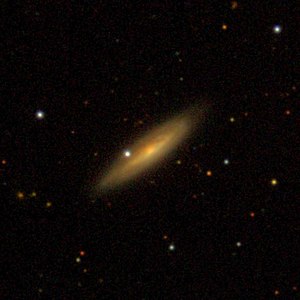NGC 7367
| Galaxy NGC 7367 |
|
|---|---|

|
|
| SDSS recording | |
| AladinLite | |
| Constellation | Pegasus |
|
Position equinox : J2000.0 , epoch : J2000.0 |
|
| Right ascension | 22 h 44 m 34.4 s |
| declination | + 03 ° 38 ′ 47 ″ |
| Appearance | |
| Morphological type | Sab: |
| Brightness (visual) | 13.9 likes |
| Brightness (B-band) | 14.7 mag |
| Angular expansion | 1.6 ′ × 0.4 ′ |
| Position angle | 128 ° |
| Surface brightness | 13.3 mag / arcmin² |
| Physical data | |
| Redshift | 0.024133 ± 0.000033 |
| Radial velocity | 7235 ± 10 km / s |
|
Stroke distance v rad / H 0 |
(330 ± 23) x 10 6 ly (101.2 ± 7.1) Mpc |
| history | |
| discovery | Albert Marth |
| Discovery date | August 29, 1864 |
| Catalog names | |
| NGC 7367 • UGC 12175 • PGC 69633 • CGCG 379-003 • MCG + 00-58-002 • 2MASX J22443443 + 0338470 • | |
NGC 7367 is a spiral galaxy of Hubble type Sab in the constellation Pegasus at the northern sky . It is estimated to be 330 million light years away from the Milky Way and has a diameter of about 155,000 ly.
In the same area of the sky are the galaxies NGC 7360 , NGC 7373 , NGC 7376 , among others .
The Type Ia supernova SN 2013dt was observed here.
The object was discovered by Albert Marth on August 29, 1864 .
